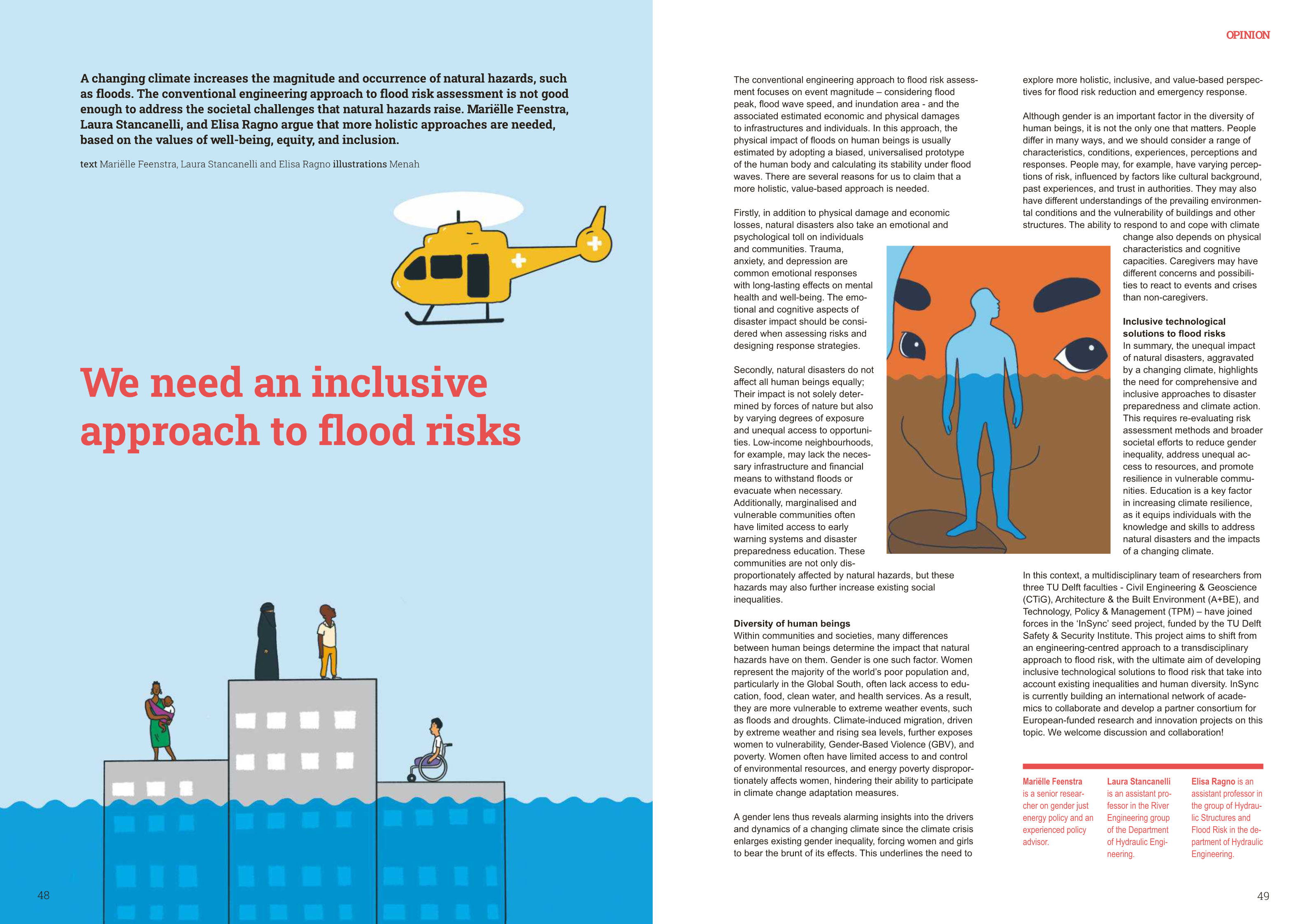We need an inclusive approach to flood risks
A changing climate increases the magnitude and occurrence of natural hazards, such as floods. The conventional engineering approach to flood risk assessment is not good enough to address the societal challenges that natural hazards raise. Mariëlle Feenstra, Laura Stancanelli, and Elisa Ragno argue that more holistic approaches are needed, based on the values of well-being, equity, and inclusion.
text Mariëlle Feenstra, Laura Stancanelli and Elisa Ragno illustrations Menah
The conventional engineering approach to flood risk assessment focuses on event magnitude – considering flood peak, flood wave speed, and inundation area - and the associated estimated economic and physical damages to infrastructures and individuals. In this pproach, the physical impact of floods on human beings is usually estimated by adopting a biased, universalised prototype of the human body and calculating its stability under flood waves. There are several reasons for us to claim that a more holistic, value-based approach is needed.
Firstly, in addition to physical damage and economic losses, natural disasters also take an emotional and psychological toll on individuals and communities. Trauma, anxiety, and depression are common emotional responses with long-lasting effects on mental health and well-being. The emotional and cognitive aspects of disaster impact should be considered when assessing risks and designing response strategies.
Secondly, natural disasters do not affect all human beings equally; Their impact is not solely determined by forces of nature but also by varying degrees of exposure and unequal access to opportunities. Low-income neighbourhoods, for example, may lack the necessary infrastructure and financial means to withstand floods or evacuate when necessary. Additionally, marginalised and vulnerable communities often have limited access to early warning systems and disaster preparedness education. These communities are not only disproportionately affected by natural hazards, but these hazards may also further increase existing social inequalities.
Diversity of human beings
Within communities and societies, many differences between human beings determine the impact that natural hazards have on them. Gender is one such factor. Women represent the majority of the world’s poor population and, particularly in the Global South, often lack access to education, food, clean water, and health services. As a result, they are more vulnerable to extreme weather events, such as floods and droughts. Climate-induced migration, driven by extreme weather and rising sea levels, further exposes women to vulnerability, Gender-Based Violence (GBV), and poverty. Women often have limited access to and control of environmental resources, and energy poverty disproportionately affects women, hindering their ability to participate in climate change adaptation measures.
A gender lens thus reveals alarming insights into the drivers and dynamics of a changing climate since the climate crisis enlarges existing gender inequality, forcing women and girls to bear the brunt of its effects. This underlines the need to explore more holistic, inclusive, and value-based perspectives for flood risk reduction and emergency response.
Although gender is an important factor in the diversity of human beings, it is not the only one that matters. People differ in many ways, and we should consider a range of characteristics, conditions, experiences, perceptions and responses. People may, for example, have varying perceptions of risk, influenced by factors like cultural background, past experiences, and trust in authorities. They may also have different understandings of the prevailing environmental conditions and the vulnerability of buildings and other structures. The ability to respond to and cope with climate change also depends on physical characteristics and cognitive capacities. Caregivers may have different concerns and possibilities to react to events and crises than non-caregivers.
Inclusive technological solutions to flood risks
In summary, the unequal impact of natural disasters, aggravated by a changing climate, highlights the need for comprehensive and inclusive approaches to disaster preparedness and climate action. This requires re-evaluating risk assessment methods and broader societal efforts to reduce gender inequality, address unequal access to resources, and promote resilience in vulnerable communities. Education is a key factor in increasing climate resilience, as it equips individuals with the knowledge and skills to address natural disasters and the impacts of a changing climate.
In this context, a multidisciplinary team of researchers from three TU Delft faculties - Civil Engineering & Geoscience (CTiG), Architecture & the Built Environment (A+BE), and Technology, Policy & Management (TPM) – have joined forces in the ‘InSync’ seed project, funded by the TU Delft Safety & Security Institute. This project aims to shift from an engineering-centred approach to a transdisciplinary approach to flood risk, with the ultimate aim of developing inclusive technological solutions to flood risk that take into account existing inequalities and human diversity. InSync is currently building an international network of academics to collaborate and develop a partner consortium for European-funded research and innovation projects on this topic. We welcome discussion and collaboration!
Mariëlle Feenstra is a senior researcher on gender just energy policy and an experienced policy advisor.
Laura Stancanelli is an assistant professor in the River Engineering group of the Department of Hydraulic Engineering.
Elisa Ragno is an assistant professor in the group of Hydraulic Structures and Flood Risk in the Department of Hydraulic Engineering.

